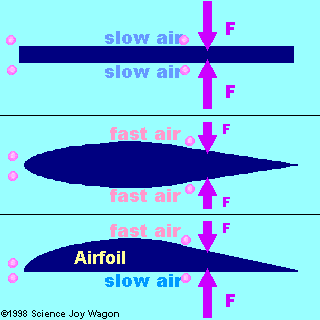| Home |
Brief History |
The
Forces |
Bernoulli's Principle |
Newtonian Principle | Angle of Attack |
Bibliography |
Bernoulli's Principle
 http://thephysicsofflight.homestead.com/airplane.html  Bernoulli's Equation http://web.mit.edu/16.00/www/aec/flight.html |
To explain how lift is generated, one might consider
Bernoulli’s Equation of Fluid Dynamics. The principle states
that as a liquid passes over the surface of an object,
it puts pressure across the surface. If the speed of the
liquid must be the same on either side and the pressure
on the top of an object is greater than that on the
bottom, the liquid must travel faster on the top than
the bottom to be equal. This causes the liquid traveling
on the top to apply less pressure than the bottom.
By looking at the equation, if the velocity (V)
increases, the pressure (P) must decrease in order for
the equation to remain constant. Because of this, the
pressure on the top is less than that on the bottom
resulting in the net force of the two opposing pressures
to point up, as shown in the image in the bottom left.
|